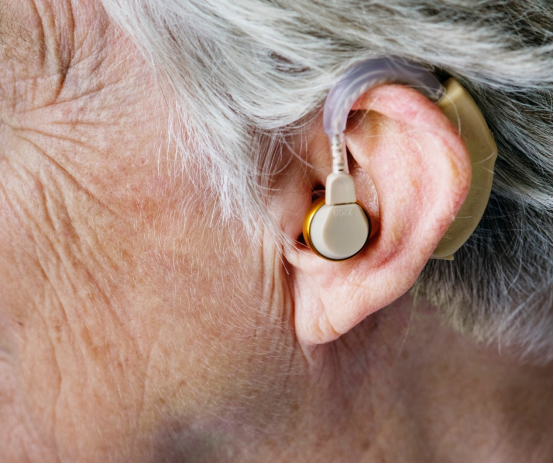Find Your Perfect Hearing Aid: A Guide to Choosing the Right Device for You
Hearing loss is a common issue that affects millions of people worldwide, and finding the right hearing aid can significantly improve quality of life. With advancements in hearing technology, today’s hearing aids are more discreet, powerful, and personalized than ever before. However, with so many options available, selecting the perfect hearing aid for your needs can be overwhelming.
Hearing loss is a common issue that affects millions of people worldwide, and finding the right hearing aid can significantly improve quality of life. With advancements in hearing technology, today’s hearing aids are more discreet, powerful, and personalized than ever before. However, with so many options available, selecting the perfect hearing aid for your needs can be overwhelming.

This guide will help you navigate the process of choosing the ideal hearing aid, taking into consideration your lifestyle, preferences, and specific hearing needs.
1. Types of Hearing Aids: Finding the Right Fit for You
There are several types of hearing aids, each designed to meet different needs. Understanding the pros and cons of each can help you choose the most suitable device for your hearing loss.
- Behind-the-Ear (BTE) Hearing Aids:These are the most common type of hearing aids. BTE devices sit behind the ear, with a tube or wire connected to a custom earpiece or earmold. BTE hearing aids are suitable for people with mild to severe hearing loss and are known for their durability, ease of use, and longer battery life. They are ideal for users who need powerful amplification.
- Receiver-in-the-Canal (RIC) Hearing Aids:These hearing aids are similar to BTEs but are smaller and more discreet. The receiver sits inside the ear canal, providing better sound quality and reducing the risk of feedback. RIC devices are comfortable and offer a more natural sound quality, making them a popular choice for people with mild to moderate hearing loss.
- In-the-Ear (ITE) Hearing Aids:These hearing aids sit inside the ear, filling the outer portion of the ear canal. ITE devices are more discreet than BTE models and are ideal for individuals with mild to severe hearing loss. They offer more features than traditional BTE aids, including enhanced comfort and sound quality.
- Completely-in-the-Canal (CIC) and Invisible-in-the-Canal (IIC) Hearing Aids:These are the smallest types of hearing aids and fit deep inside the ear canal, making them virtually invisible to others. CIC and IIC hearing aids are best for people with mild to moderate hearing loss who value discretion. They are less noticeable but may be harder to adjust and may not have as many advanced features as larger models.
2. Technology Features to Consider
Modern hearing aids come with a variety of advanced features to improve sound quality, comfort, and convenience. Here are some features to consider when choosing your hearing aid:
- Directional Microphones:These microphones enhance sounds coming from in front of you while reducing background noise from other directions. This feature is particularly beneficial in noisy environments, such as restaurants or social gatherings.
- Noise Reduction:Noise reduction technology helps to minimize background noise, making it easier to focus on the conversation or sounds that matter most. This feature is important for individuals who frequently find themselves in noisy settings.
- Bluetooth Connectivity:Many modern hearing aids are equipped with Bluetooth capabilities, allowing you to wirelessly connect to your smartphone, television, or other audio devices. This feature provides better sound quality and convenience for streaming music, phone calls, or TV audio directly to your hearing aid.
- Rechargeable Batteries:Rechargeable hearing aids are increasingly popular, offering the convenience of not having to replace batteries constantly. You simply place them in a charging station overnight for a full day’s worth of power. Rechargeable options are environmentally friendly and eliminate the hassle of changing small batteries.
- Smartphone Apps:Many hearing aids now come with companion apps that allow you to adjust the volume, change settings, and even track your hearing aid’s performance. Apps can also help you find your hearing aids if they go missing or provide real-time feedback on your hearing environment.
- Waterproof or Water-Resistant:If you live an active lifestyle or enjoy outdoor activities, you may want a hearing aid that is water-resistant or even waterproof. This ensures that your device remains protected from sweat, rain, or water activities like swimming.
3. Choosing the Right Amplification for Your Hearing Loss
Hearing aids come in various amplification levels, which are tailored to the degree of your hearing loss. Your audiologist will conduct a hearing test to determine the severity of your hearing loss and recommend the appropriate amplification.
- Mild Hearing Loss:If you only experience mild hearing loss, a small, discreet hearing aid may be enough. Many people with mild hearing loss can benefit from smaller models like CIC or IIC hearing aids, which provide sufficient amplification without sacrificing comfort or appearance.
- Moderate to Severe Hearing Loss:People with more significant hearing loss often need a more powerful hearing aid, such as BTE or RIC models, which can provide the necessary amplification and clarity. These models are also equipped with more advanced technology for noise reduction and speech enhancement.
- Severe to Profound Hearing Loss:For those with severe or profound hearing loss, high-power hearing aids are essential. Some models come with extra features to improve sound clarity, such as dual microphones and advanced digital signal processing, to maximize the effectiveness of amplification.
4. Budgeting for Your Hearing Aid
Hearing aids are an investment in your health and quality of life, but they can also be costly. Prices can vary depending on the type of device, features, and brand. It’s important to consider both the upfront cost and long-term maintenance when making your decision.
- Cost Considerations:Hearing aids can range from a few hundred to several thousand dollars per device, depending on the features and technology. Most insurance plans do not cover hearing aids, but some may offer partial coverage. It's essential to check with your insurance provider or explore financing options.
- Extended Warranties and Aftercare:Many hearing aid manufacturers offer warranties that cover repairs, adjustments, or replacements for a specified period. Additionally, some companies offer aftercare packages, which include services such as cleaning, maintenance, and adjustments over time. Consider these options when budgeting for your device.
- Hearing Aid Subsidies and Programs:Some non-profit organizations, government programs, or foundations offer financial assistance for people who cannot afford hearing aids. It's worth exploring local resources and programs that may help reduce the cost of your device.
5. Finding the Right Fit: Working with an Audiologist
An audiologist plays a key role in finding the right hearing aid for you. They will conduct a comprehensive hearing evaluation, take into account your lifestyle, and recommend the best device for your hearing needs.
- Consultation and Hearing Tests:Your audiologist will start by conducting a hearing test to assess the type and degree of hearing loss. This test will help guide the recommendation for the appropriate hearing aid.
- Fitting and Adjustment:After selecting a hearing aid, the audiologist will ensure that the device fits comfortably in your ear. Adjustments will be made to fine-tune the sound quality based on your hearing preferences. This process may take a few visits to ensure that you are comfortable with your hearing aid and that it provides the best amplification.
- Ongoing Support and Maintenance:Regular follow-up appointments with your audiologist will help you maintain optimal hearing performance. They can also assist with cleaning, adjustments, or troubleshooting if problems arise with your device.
6. Lifestyle Considerations: Choosing a Hearing Aid for Your Needs
Finally, consider how your lifestyle and daily activities impact your hearing aid choice. For example:
- Social Activities and Conversations:If you frequently attend social gatherings, you may want a hearing aid with excellent noise reduction and directional microphones to help you focus on conversations in noisy environments.
- Work Environment:If you work in a noisy setting, a more powerful hearing aid with advanced noise-canceling features may be beneficial. For quiet work environments, a discreet and small hearing aid may be sufficient.
- Active Lifestyle:For those who enjoy sports or outdoor activities, look for a durable, waterproof, or water-resistant hearing aid that can withstand sweat and exposure to the elements.
Conclusion: Your Journey to Better Hearing
Finding the perfect hearing aid is an important decision that will have a lasting impact on your hearing and overall quality of life. With the right knowledge and guidance, you can confidently choose a hearing aid that meets your needs, preferences, and lifestyle.
Remember, working with an audiologist is key to ensuring you get the best possible hearing aid for your unique situation. By considering factors such as type, technology features, amplification needs, and your lifestyle, you’ll be well on your way to enjoying better hearing and a fuller, more vibrant life.








